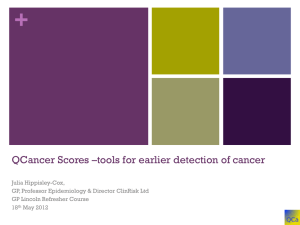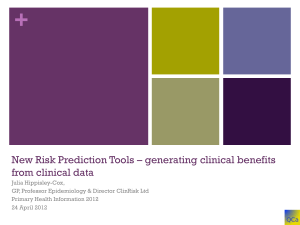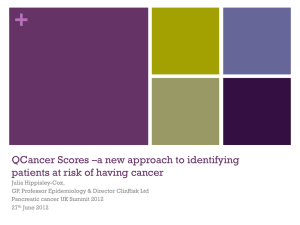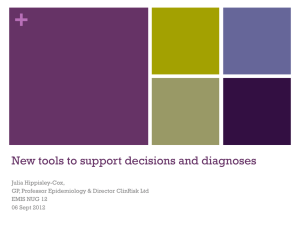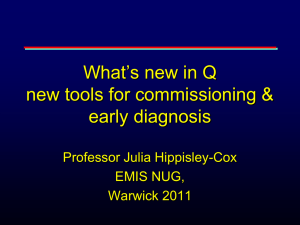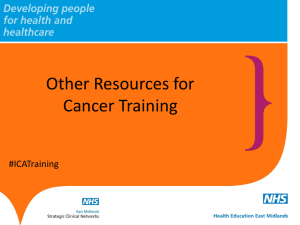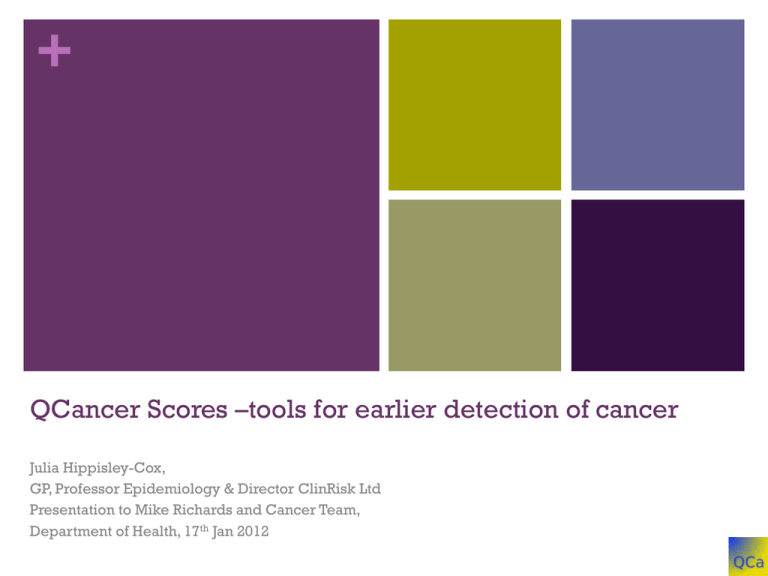
+
QCancer Scores –tools for earlier detection of cancer
Julia Hippisley-Cox,
GP, Professor Epidemiology & Director ClinRisk Ltd
Presentation to Mike Richards and Cancer Team,
Department of Health, 17th Jan 2012
+
Acknowledgements
Co-author Dr Carol Coupland
QResearch database
University of Nottingham
ClinRisk (software)
EMIS & contributing practices & User Group
BJGP and BMJ for publishing the work
Oxford University (independent validation)
Like to work with cancer teams, DH + RCGP+ other academics
whose work we have built on.
+
QResearch Database
Over 700 general practices across the UK, 14 million patients
Joint not for profit venture University of Nottingham and EMIS
(supplier > 55% GP practices)
Validated database – used to develop many risk tools
Available for peer reviewed academic research where
outputs made publically available
Practices not paid for contribution but get integrated
QFeedback tool and utilities eg QRISK, QDScore.
Data linkage – deaths, deprivation, cancer, HES
+
The Research Cycle
‘clinically useful epidemiology - new knowledge & utilities to improve patient
care’
+
QFeedback – integrated into EMIS
+
QScores – new family of Risk Prediction
tools
Individual assessment
Who is most at risk of preventable disease?
Who is likely to benefit from interventions?
What is the balance of risks and benefits for my patient?
Enable informed consent and shared decisions
Population level
Risk stratification
Identification of rank ordered list of patients for recall or reassurance
GP systems integration
Allow updates tool over time, audit of impact on services and
outcomes
+
Current published & validated
QScores
scores
outcome
Web link
QRISK
CVD
www.qrisk.org
QDScore
Type 2 diabetes
www.qdsore.org
QKidney
Moderate/severe renal failure
www.qkidney.org
QThrombosis
VTE
www.qthrombosis.org
QFracture
Osteoporotic fracture
www.qfracture.org
Qintervention
Risks benefits interventions to www.qintervention.org
lower CVD and diabetes risk
QCancer
Detection common cancers
www.qcancer.org
+
Qcancer ‘diagnostic’ scores
Currently 6 QCancer scores :
Colorectal
Lung
Gastro-oesophageal
Pancreas
Ovary
Renal
+
QCancer scores – what they need
to do
Accurately predict level of risk for individual based on risk
factors and symptoms
Discriminate between patients with and without cancer
Help guide decision on who to investigate or refer and
degree of urgency.
Educational tool for sharing information with patient.
Sometimes will be reassurance.
+
QCancer scores – approach taken
Maximise strengths of routinely collected data electronic databases
Large representative samples including rare cancers
Algorithms can be applied to the same setting eg general practice
Account for multiple symptoms
Adjustment for family history
Better definition of smoking status (non, ex, light, moderate, heavy)
Age – absolutely key as PPV varies hugely by age
updated to meet changing requirements, populations, recorded data
+
Incidence of key symptoms vary
by age and sex
+
PPV of symptoms also vary by age
in men (Jones et al BMJ 2007).
20
18
16
14
12
10
8
6
4
2
0
45-54 yrs
55-64 yrs
65-74 yrs
75-84 yrs
haematuria haemoptysis dysphagia
rectal
bleeding
+
And PPV vary by age in women
(Jones et al BMJ 2007).
12
45-54 yrs
55-64 yrs
65-74 yrs
75-84 yrs
10
8
6
4
2
0
haematuria haemoptysis dysphagia
rectal
bleeding
+
Methods – development algorithm
Huge representative sample from primary care aged 30-84
Identify new alarm symptoms (eg rectal bleeding,
haemoptysis) and other risk factors (eg age, COPD, smoking,
family history)
Identify cancer outcome - all new diagnoses either on GP
record or linked ONS deaths record in next 2 years
Established methods to develop risk prediction algorithm
Identify independent factors adjusted for other factors
Measure of absolute risk of cancer. Eg 5% risk of colorectal
cancer
+
Methods - validation
Previous QScores validation – similar or better performance
on external data
Once algorithms developed, tested performance
separate sample of QResearch practices
fully external dataset (Vision practices) at Oxford University
Measures of discrimination - identifying those who do and
don’t have cancer
Measures of calibration - closeness of predicted risk to
observed risk
Measure performance – PPV, sensitivity, ROC etc
+ Results – the algorithms/predictors
Outcome
Risk factors
Symptoms
Lung
Age, sex, smoking,
deprivation, COPD,
prior cancers
Haemoptysis, appetite loss, weight loss,
cough, anaemia
Gastrooeso
Age, sex, smoking
status
Haematemsis, appetite loss, weight loss,
abdo pain, dysphagia
Colorectal Age, sex, alcohol,
family history
Rectal bleeding, appetite loss, weight loss,
abdo pain, change bowel habit, anaemia
Pancreas
Age, sex, type 2,
chronic pancreatitis
dysphagia, appetite loss, weight loss,
abdo pain, abdo distension, constipation
Ovarian
Age, family history
Rectal bleeding, appetite loss, weight loss,
abdo pain, abdo distension, PMB, anaemia
Renal
Age, sex, smoking
status, prior cancer
Haematuria, appetite loss, weight loss,
abdo pain, anaemia
+
Discrimination QCancer scores
ROC values for women
0.94
0.92
0.9
0.88
0.86
0.84
0.82
0.8
0.78
0.76
lung
renal
colorectal gastroes pancreas
ovary
+
Calibration - observed vs
predicted risk for ovarian cancer
+
Sensitivity for top 5% and 10% of
predicted risk
Cut point
Threshold
top 10%
Pick up
rate for
10%
Cut point
threshold
top 5%
Pickup rate
for 5%
Colorectal
0.5
71
1.2
56
Gastro-oeso
0.2
77
0.4
65
Ovary
0.2
63
0.5
42
Pancreas
0.2
62
0.3
45
Renal
0.1
87
0.3
81
Lung
0.4
77
0.7
63
+
Symptom recording in ovarian
cancer: cohort vs controls
QCancer BMJ (2012)
Hamilton BMJ (2009)
Abdominal pain
11.4%
8.7%
Abdominal distension
0.4%
0.6%
Loss appetite
0.5%
1.5%
Post menopausal
bleeding
1.6%
1.1%
Rectal bleeding
2.2%
1.5%
Weight loss
1.2%
Not reported
Note: different sample – QCancer national cohort 30-84 years
Hamilton local sample age matched controls 40+
+
Difference in age structure Exeter
vs QResearch vs ONS
35
30
25
20
Qcancer
ONS
Hamilton
15
10
5
0
30-39
40-49
50-59
60-69
70-79
80+
+
Using QCancer in practice
Standalone tools
a.
Web calculator www.qcancer.org
b.
Windows desk top calculator
c.
Iphone – simple calculator
Integrated into clinical system
a.
Within consultation: GP with patients with symptoms
b.
Batch: Run in batch mode to risk stratify entire practice or
PCT population
+
GP system integration:
Within consultation
Uses data already recorded (eg age, family history)
Stimulate better recording of positive and negative symptoms
Automatic risk calculation in real time
Display risk enables shared decision making between doctor
and patient
Information stored in patients record and transmitted on referral
letter/request for investigation
Allows automatic subsequent audit of process and clinical
outcomes
Improves data quality leading to refined future algorithms.
+
Iphone/iPad
+
GP systems integration
Batch processing
Similar to QRISK which is in 90% of GP practices– automatic
daily calculation of risk for all patients in practice based on
existing data.
Identify patients with symptoms/adverse risk profile without
follow up/diagnosis
Enables systematic recall or further investigation
Systematic approach - prioritise by level of risk.
Integration means software can be rigorously tested so ‘one
patient, one score, anywhere’
Cheaper to distribute updates
+
Clinical settings
Modelling done on primary care population
Intended for use in primary care setting ie GP consultation
Potential use in other clinical settings as with QRISK
Pharmacy
Supermarkets
‘health buses’
Secondary care
Potential use by patients - linked to inline access to health
records.
+
Summary key points
Individualised level of risk - including age, FH, multiple
symptoms
Electronic validated tool using proven methods which can be
implemented into clinical systems
Standalone or integrated.
If integrated into computer systems,
improve recording of symptoms and data quality
ensure accuracy calculations
help support decisions & shared decision making with patient
enable future audit and assessment of impact on services and
outcomes
+
Discussion and next steps

